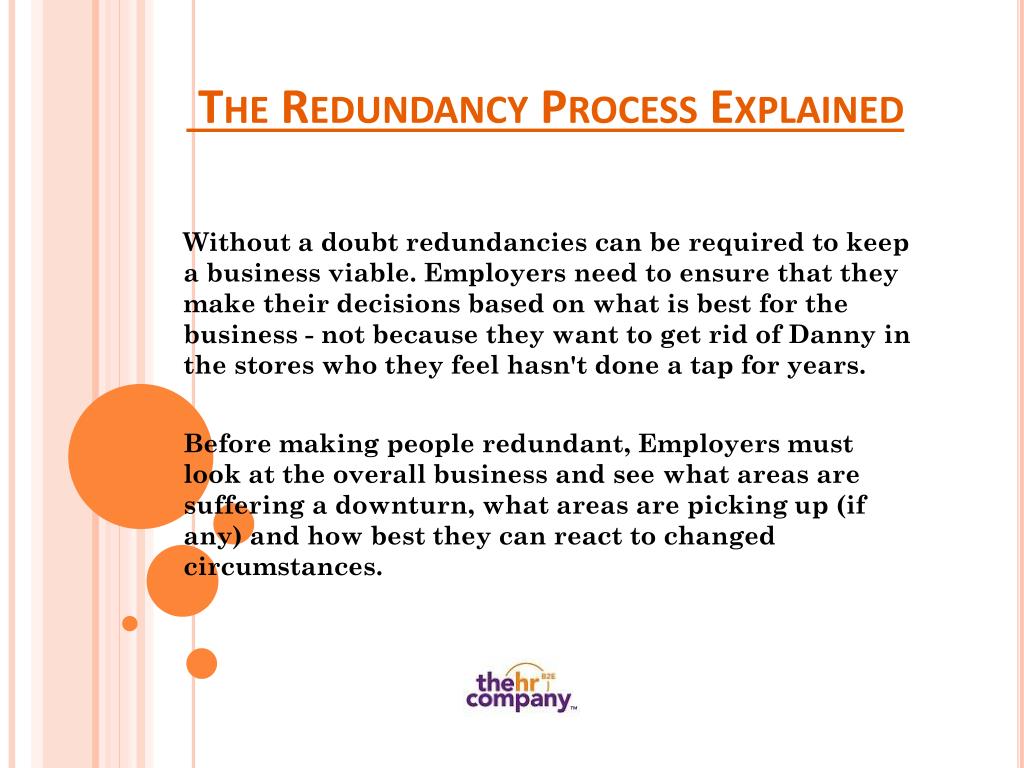Who Pays Redundancy Money? A Comprehensive Overview for Companies and Employees
Who Pays Redundancy Money? A Comprehensive Overview for Companies and Employees
Blog Article
Checking Out the Interaction In Between Business Redundancy and Business Versatility for Future Growth
In the vibrant landscape of today's company world, the intricate partnership in between business redundancy and organizational versatility emerges as a vital factor for continual development and success. Firms commonly encounter the challenge of striking a delicate balance in between maintaining a level of redundancy to mitigate dangers and promoting adaptability to react quickly to the ever-evolving market demands.
Significance of Business Redundancy
Business redundancy is an important element that improves business resilience and mitigates operational risks. By integrating redundancy measures within the organizational structure, business can much better hold up against unforeseen interruptions and variations in business atmosphere. Redundancy serves as a tactical buffer, allowing firms to adapt and respond efficiently to unanticipated difficulties without jeopardizing essential operations.
One key element of the importance of company redundancy is its function in guaranteeing connection during times of dilemma. When faced with sudden changes or emergencies, redundant systems, resources, or personnel can step in to maintain vital features and avoid prevalent disruptions. This connection not only safeguards the business's track record and consumer trust fund yet additionally reduces economic losses and operational downtime.

Strategies for Organizational Adaptability

One more vital strategy is buying modern technology and infrastructure that can sustain flexibility and scalability. Carrying out electronic tools, automation, and information analytics can improve operations, improve performance, and provide important insights for notified decision-making. Moreover, developing adaptable organizational frameworks that enable fast changes to market characteristics and customer requirements is necessary for staying competitive in a rapidly evolving atmosphere. By proactively determining prospective disturbances and possibilities, companies can proactively thrive and adapt in an ever-changing service landscape.
Balancing Redundancy and Versatility
Attaining a harmonious stability between functional redundancy and organizational flexibility is paramount in browsing the complexities of a vibrant organization environment. Redundancy within a company gives a safeguard, making certain connection and security in procedures. Nonetheless, an excess of redundancy can result in inefficiencies and impede versatility to altering market problems. On the other hand, business versatility allows firms to react quickly to external disturbances and take new chances. Striking the appropriate equilibrium in between redundancy and adaptability is a delicate process that requires a deep understanding of the company's goals, sector dynamics, and threat tolerance.
To click to investigate accomplish this equilibrium, firms need to carry out routine evaluations of their procedures to identify areas where redundancy is required for risk mitigation and where versatility can drive innovation and development. Implementing adaptable structures, cultivating a culture of continual knowing and enhancement, and encouraging open interaction throughout all levels of the company are essential approaches to balance redundancy and versatility effectively. By aligning these two important components, firms can place themselves for lasting growth and success in an ever-changing organization landscape.
Instance Researches on Adaptation Success
In taking a look at instances of effective organizational adaptation, it becomes apparent that the interaction between operational redundancy and adaptability is a specifying element in forming resistant companies. One engaging study is that of Netflix. At first a DVD rental service, Netflix demonstrated impressive flexibility by transitioning into a streaming system when digitalization interrupted the industry. By purposefully investing in modern technology and material creation, Netflix not just prospered yet endured in her comment is here a quickly developing market. One more standout instance is Amazon. Beginning as an on-line bookstore, Amazon continuously adjusted its company model, broadening into varied sectors such as cloud computing and man-made knowledge. This adaptability enabled Amazon to stay ahead of competitors and fulfill transforming consumer demands. Lastly, Adobe gives a significant illustration of successful adaptation. The company changed from selling software application licenses to a subscription-based model, ensuring repeating revenue streams and boosted client engagement. These situation research studies highlight the importance of operational redundancy combined with organizational flexibility in cultivating long-lasting growth and competition.
Building Strength for Future Development
Structure strength for future growth needs a critical positioning of find here operational procedures with market dynamics and emerging trends. Business must adapt to changing environments by cultivating a society of versatility, advancement, and continuous renovation. Durability includes not only bouncing back from troubles yet additionally proactively getting ready for future difficulties. One key facet of building resilience is buying durable risk administration methods to alleviate possible disturbances. This consists of circumstance planning, branching out supply chains, and establishing backup prepare for numerous backups (who pays redundancy money).
Furthermore, fostering strong relationships with stakeholders, such as consumers, employees, suppliers, and the community, is essential for weathering unpredictabilities and maintaining trust and assistance throughout stormy times. Effective communication and openness play a crucial duty in structure resilience, as they assist align assumptions and help with collaboration in browsing unpredictabilities.
In addition, companies need to focus on knowing and advancement campaigns to upskill staff members and outfit them with the required devices to adjust to altering situations. By spending in their labor force, business can improve their flexibility and agility, ultimately strengthening their durability for sustainable future growth.
Verdict

In the vibrant landscape of today's company world, the elaborate partnership in between company redundancy and business adaptability arises as a critical variable for continual growth and success. Business frequently face the obstacle of striking a fragile balance in between preserving a degree of redundancy to alleviate risks and promoting adaptability to react swiftly to the ever-evolving market needs.To achieve this balance, business need to perform regular analyses of their procedures to recognize locations where redundancy is required for danger mitigation and where adaptability can drive development and development.In verdict, the interplay between company redundancy and organizational flexibility is vital for future growth. Structure durability with a combination of redundancy and adaptability will make certain that business are prepared for the difficulties of the future.
Report this page